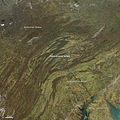File:Appalachian Pennsylvania salient satfoto.jpg
Appearance

Size of this preview: 600 × 600 pixels. Other resolutions: 240 × 240 pixels | 480 × 480 pixels | 720 × 720 pixels.
Original file (720 × 720 pixels, file size: 275 KB, MIME type: image/jpeg)
File history
Click on a date/time to view the file as it appeared at that time.
| Date/Time | Thumbnail | Dimensions | User | Comment | |
|---|---|---|---|---|---|
| current | 00:31, 24 September 2014 |  | 720 × 720 (275 KB) | Tillman | {{Information |Description ={{en|1= For decades, geologists have debated the origins of an unmistakable curve in the Appalachian Mountains. Known to experts as the “Pennsylvania salient,” the bend begins in southern New York and northeastern Pe... |
File usage
The following 2 pages use this file:
Global file usage
The following other wikis use this file:
- Usage on sv.wikipedia.org


